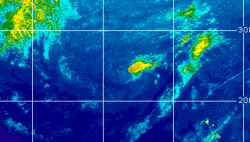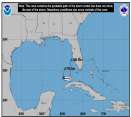bahamaweather
Verified CFHC User
Reged:
Posts: 11
Loc: Abaco, Bahamas
|
|
Quick question, how common is it for a storm to pass through a Hebert Box, but not affect South Florida or the SE USA?
(Post moved to the appropriate Forum.)
Edited by Ed Dunham (Sun Aug 29 2010 10:32 AM)
|
MikeC
Admin
Reged:
Posts: 4673
Loc: Orlando, FL
|
|
Jim Williams spent a lot of time on the Hebert box, so it winds up:
1. North Carolina has as much of a chance to get hit as Florida.
2. 20.58% or most go out to sea without hitting land.
3. Only 8.82% make it into the Gulf of Mexico when they pass through the box as a hurricane.
4. Puerto Rico will get hit 20.58% of the time (the highest outside of n Antilles).
|
Ed Dunham
Former Meteorologist & CFHC Forum Moderator (Ed Passed Away on May 14, 2017)
Reged:
Posts: 2565
Loc: Melbourne, FL
|
|
That quick question would require a considerable amount of research on past tracks of major hurricanes. Here is a quick synopsis: "If a Category Three, Four or Five storm, born in the Atlantic, misses the region bordered by latitudes 15 and 20 degrees north and longitudes 60 and 65 degrees west, it virtually always misses South Florida. " Notice that the storm must be a major hurricane within the box to pose a threat to Florida. Here is a link to past storms where you can check it out:
Unisys Weather
Let us know what the results were.
ED
|
BryanG
Registered User

Reged:
Posts: 6
Loc: North of Tampa, FL
|
|
So this discussion is now even more interesting. Earl is now a major storm, and in the box, so this storm will become a statistic if it wants to or not.
I have been watching this site since I moved to the Tampa area in 2007, this place is GREAT.
My question, with the storm in the box, and Major, should south Florida be more watchful of it? following the forecasts it should recurve (right term?) and may miss the US altogether. However it is going west, how long can it run west before it becomes more a concern to Florida and all those south of Florida?
I am reading about a ridge that is still pushing the storm west, is it possible for the storm to get caught on the wrong side of that ridge and not turn east at all?
Please for give my ignorance, but I am reading and learning more every season, now that this is home 
|
Ed Dunham
Former Meteorologist & CFHC Forum Moderator (Ed Passed Away on May 14, 2017)
Reged:
Posts: 2565
Loc: Melbourne, FL
|
|
One of my goals (and that of many others on the site) is not just to track storms but to teach others about them. Notice that I said 'pose a threat' to Florida, not necessarily hit it, others have passed through the box in the past but have missed the state. You are correct in assuming that normally the threat is greater for south Florida, and you are also correct in that the storm can indeed get caught on the wrong side of the ridge, i.e., its not picked up by the trough but instead gets blocked by the ridge behind it and does not move off to the northeast. Sometimes tropical cyclones can slow down for days before they finally head off to the north northeast on the back side of the western extension of the ridge. When this happens (more often than I care for) the storm can get rather close to Florida - and its still one of a few scenarios that can play out with Earl. Hurricane Bertha in 1996 is a classic example of this. Bertha was expected to turn on every advisory as she approached Florida - but she didn't. Finally the hurricane got too close and so from a safety standpoint east central Florida beachside communities were evacuated - and two and a half hours later she turned!
Here is a link to Bertha - notice how similar the track is to what Earl has been doing.
UNISYS Track of Hurricane Bertha
Cheers,
ED
|




 Threaded
Threaded





